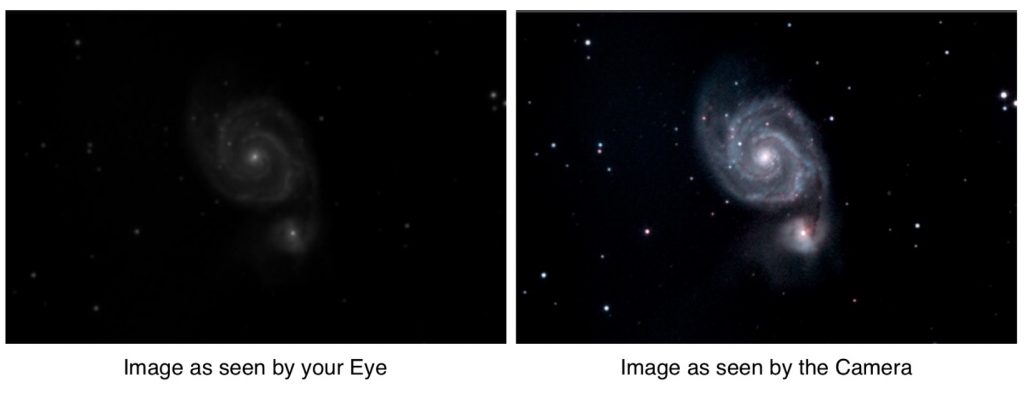Learn to Capture the Beauty of the Night Sky with your DSLR Camera
After all the excitement of viewing celestial objects through your telescope, if you are at all creative, you wonder about how you can preserve the image you are seeing, and share it with others, by capturing it through the processes of Basic Astrophotography.
One of the main challenges with visual astronomy, especially with beginners, is that deep sky objects generally appear very different in the eyepiece of the telescope, as compared to the pictures they have seen that initially attracted them to the hobby. In the telescope, most objects appear ghostly white and without color. That’s because the sensory cells in our eyes just are not excited enough by the dim levels of light coming from these objects through the eyepiece. Not to say that the photons are dull and boring, it’s just that they are dim!

But everything changes when you use a camera and start taking time exposures: setting your camera to open its shutter for much longer than usual, as compared to when you take terrestrial photos or normal snapshots. These pale deep sky objects then appear in vivid colors like reds, pinks, greens, and blues, and are sublime to behold. When you capture your first successful astrophoto and see that color, it is absolutely amazing and you will definitely be hooked.
These “Extra” episodes were among the most popular episodes of the entire video series.
The Episodes
There are 5 Star Hopping “Extras” that comprise the Astrophotography series (as of the time of this writing). Just click on the movie to play it – you can select full screen if you’d like.
Episode 22 – Astrophotography with a Fixed Tripod
Let’s talk about time exposures using a fixed tripod. There are lots of cool opportunities for great images here. Star Trails, quick Milky Way shots, planetary conjunctions, etc. These are quick and easy!
Episode 24 – Piggyback Astrophotography
Piggybacking is a little more difficult than basic Tripod astrophotography because it requires more equipment, and you’ll need to know your way around your telescope. I can help with that in this episode. !
Episode 26 – Prime Focus Photography
Mounting your camera at the Prime Focus of a telescope means you are essentially using the telescope’s optics as a long telephoto lens, which gives you much more effective magnification than using a regular telephoto lens attached to your camera as normal.
Episode 29 – Astrophotography using an Autoguider
In this Extra episode of Star Hopping, we’ll be discussing the process of using an AutoGuider to automate your astrophoto imaging. This topic is targeted more toward our intermediate astrophotographers out there.
Episode 48 – Time Lapse Astrophotography
In this episode I’ll show you the basics required to create time lapse movies of the night sky. I’m sure you have seen these before; movies showing the motion of the stars across the sky, moon or sun setting, and other fascinating movies that compress a very large amount of time into 30 seconds or less.
The Books
I have an eBook available in our Digital Bookstore that collects the original four episodes together, complete with illustrations and additional content.
The Star Hopping Guide to Basic Astrophotography
This useful 38 page guide provides an introduction to the basic types of astrophotography, for those of you that always have been interested in this exciting activity, but never knew where to begin.
